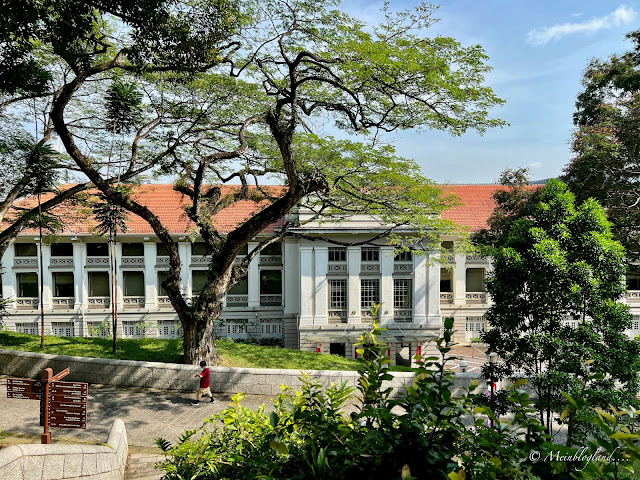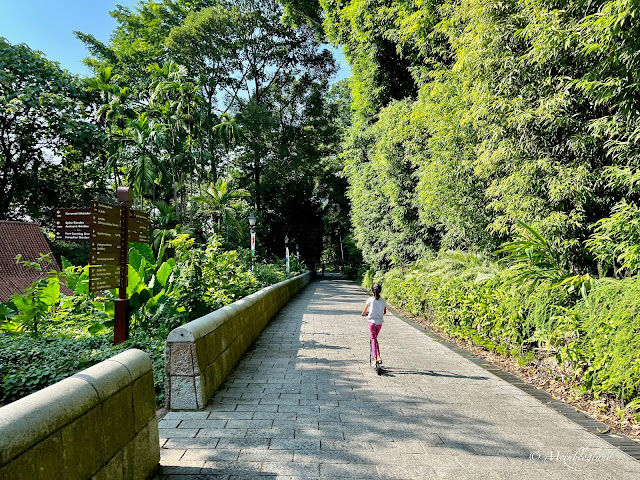Fort Canning Park is an iconic hilltop landmark in Singapore which has witnessed many of the island's historical milestones.
The park dates back to when Malay royalty once ruled in medieval times. Through time, it served as the Headquarters of the Far East Command Centre and British Army Barracks. The decision to surrender Singapore to the Japanese in 1942 was also made on the hill, in the Underground Far East Command Centre, commonly known as Battle Box. More recently, the park has turned into a venue for celebrations and plays host to exhibitions, concerts, theatre productions and festivals. Weddings, parties and gatherings are also a common sight at the park's expansive lawns.
The park was originally known as Bukit Larangan, or 'Forbidden Hill' in Malay as it was believed to be haunted. It was renamed Fort Canning in 1861 after Viscount Charles John Canning, the first Viceroy of India.
Although small in terms of area, the hill has a long history intertwined with that of the city-state due to its location as the highest elevation within walking distance to the downtown city area. Today, the 18-hectare space surrounded by centuries old gateways and gazebos is a hotspot of attractions—from ancient artefacts for history buffs to manicured lawns for outdoor recreation and lush greenery for nature lovers.
The charming boutique Hotel Fort Canning, is also situated within the premises.
Back in 2014, we stayed at Hotel Fort Canning as part of a babymoon staycation and spent a few days leisurely exploring the park. We hadn't been back since and it had always been on my list of places to visit with the kids.
Fort Canning Park
A few months ago, I picked Fort Canning Park as a scootering venue for the girls followed by a visit to the National Museum of Singapore located nearby and finally a family lunch at Hotel Fort Canning to relive some fond memories.
After parking, one of the first sights we came across was the Gothic Gate. This archway serves as the entrance to Fort Canning Green and is marked with the letters “IHS” which translates to Iota Eta Sigma (the first three letters of the Greek word of Jesus).
There are enough sign posts and information boards so you can go about exploring the park in an organized manner. If you go with kids in tow, I encourage you to let them read for themselves and try to grasp the history of our Little Red Dot 😊
The ASEAN Sculpture Garden is the first garden that we encountered. There are 5 sculptures signifying different things that are put up for display in the garden.
We came across The Battle Box aka the Underground Far East Command Centre. During the Second World War, Lieutenant General Arthur Ernest Percival (Commander of British Forces) used the underground bunkers at Fort Canning as his commanding base.
I remember the 9-Pound Cannon from my previous visit to the park. Dating back to the 19th century, the cannon was said to be fired thrice daily to announce the hour; it was also fired to warn about town fires or even as a salute. The South Battery sits next to the cannon, and this is where the main gun battery was mounted to defend Singapore.
Fort Canning Park has wide open paths flanked by soothing greenery that makes it a great location for scootering, cycling, walking or running.
We came to the Maritime Corner@Fort Canning. This is where visitors can learn about Singapore’s evolution from port city to booming maritime centre. We saw the majestic Fort Canning Lighthouse but we couldn't enter it.
Fort Canning Park features nine themed gardens - the Pancur Larangan, Artisan’s Garden, Sang Nila Utama Garden, Jubilee Park, Raffles Garden, First Botanic Garden, Farquhar Garden, Spice Garden and Armenian Street Park.
There are some truly stunning trees in the park. Just take a look at this one!
The Sang Nila Utama Garden makes you feel like you have landed in Bali. The distinctive split gates and symmetrical layout are all features of Javanese architecture.
This is a charming garden. There are lots of plants, stone sculptures and ponds.
Methinks I could fool a bunch of gullible folks with this picture by telling them it was taken in Bali 😁
The girls were thrilled to be riding their scooters in such scenic surroundings. Despite it being the weekend, much to our luck, the park was not crowded and it felt almost like we had the place to ourselves.
Like I mentioned before, Fort Canning Park is where nature meets history. We checked out the Fort Gate. This singular block is what’s left of the fortress that once stood on Fort Canning Hill from 1861 to 1926. It protected Singapore from sea-based attacks and also served as a refuge for the European population that lived here at the time.
The girls were excited when we came across these secret passages which I understand are called Sally ports.
I really wanted to check out the the Fort Canning Tree Tunnel (a prominent feature on IG). We ended up walking around aimlessly a fair bit before we were able to locate it.
This is an underground crossing that hides what is fondly known as the Fort Canning spiral staircase. With sunlight filtering through the plants and greenery, it is indeed a picturesque spot but I was surprised by how small it was (on social media, it tends to look cavernous). I was even more surprised (shocked even!) to see the queue of people waiting to get a shot. Even though I may be considered a social media influencer myself, I must admit that I find influencers infuriating! 😂 I do not have the patience/am not that vain/don't care that much about social media so I did not even entertain the idea of standing in the queue. This picture is of a random stranger who was getting their picture taken at the time.
We were running out of time so we didn't go to Pancur Larangan (Forbidden Spring) which used to be an area where the wife and consorts of the King used to take their baths. Located nearby is also Jubilee Park which is a nature-inspired free playground with lots of space and play structures for kids to explore set amidst the lush greenery of Fort Canning. We decided to keep these two places for a subsequent visit.
The National Museum of Singapore
The National Museum of Singapore is the nation's oldest museum that seeks to inspire with stories of Singapore and the world. Its history dates back to 1849.
Known then as the Raffles Library and Museum, the museum moved to its current premises on Stamford Road in 1887.
We entered The Singapore History, The gallery’s updated narrative charts the development of the island as it was known through the years as Singapura, a Crown Colony, Syonan-To, and finally, Singapore.
In 1819, Sir Stamford Raffles and Major William Farquhar arrived in Singapore. They struck a deal with the local Malay rulers to set up a British trading port, which brought in traders and ships from as far away as Arabia and Africa.
Singapore became a Crown colony in 1867. As the British empire flourished, so did Singapore. By 1919, Singapore was a modern city, boasting the second largest dry dock in the world with modern conveniences such as electricity, motorcars, and international telegraph and telephone connections.
In this section of the museum visitors will discover key historical figures and how they helped to catapult Singapore to become the centre of trade in Southeast Asia.
There are displays depicting the ways of life in Singapore of the yesteryears.
I was highly amused when my kids spotted an antiquated telephone (the one with a rotary dial) and asked me what it was 😆 In that moment I felt old because we used to have such a telephone when I was a kid growing up in the 80s.
After World War Two, a wave of decolonisation began to sweep through Asia and Africa. In 1959, Singapore was granted self-government and the first general election for a fully-elected government was held. The People’s Action Party (PAP) won and its leader, Lee Kuan Yew, became Singapore’s first prime minister. Following a merger with, and then separation from, Malaysia, Singapore became a fully independent nation in 1965.
Over the next two decades, the government tackled the challenges faced by the growing nation, such as unemployment and insufficient housing. It took bold steps to introduce industrialisation, encourage foreign investment and tourism, provide modern public housing and education, and clean up the environment.
The artefacts here provide a glimpse into some of these key developments in the years following Singapore’s independence.
Created by the renowned Japanese digital art collective teamLab and presented in the Glass Rotunda, Story of the Forest is an immersive installation that transforms 69 drawings from the William Farquhar Collection of Natural History Drawings into three-dimensional animations. The artwork touches on various histories, that of the site it is presented in as well as the muses it features. Through a virtual and visual landscape, this installation presents Singapore’s colonial past in contrast to its present-day modernity.
It happened to be Singapore's 57th Birthday weekend that we were there and there were some traditional games arranged including Chapteh which our Singapore born and bred children knew all about but we had no clue! The game involves keeping a feathered shuttlecock in the air for as long as possible by kicking it up with the heel of the foot. This requires considerable dexterity and balance, unfortunately two traits I can't boast of 😄
We were famished after spending an eventful morning and so we retreated to the cool comfort of Hotel Fort Canning and enjoyed a hearty lunch. It was a fitting end to a wonderful day.
Summary of our visit:
The highlights of For Canning Park include the Maritime Corner at Fort Canning which tells the story of Singapore's evolution from an entrepot trading post to an international maritime centre, and the Fort Gate, the remnants of a fortress built that was built in the 19th century. Also the ASEAN Sculpture Garden, Battle Box, Sang Nila Utama Garden and Spice Garden are popular features. The Fort Canning Tree Tunnel in my opinion is rather overhyped but you can consider stopping by if you visit on a weekday or at a non-peak time.
Whether you are drawn by the park’s ancient artefacts and rich heritage or simply its tranquility, this hilltop park offers something for the whole family. An added bonus is the National Museum of Singapore where one can get acquainted with Singapore's colorful history and diverse cultural influences.
Address:
River Valley Rd, Singapore 179037
How to get there:
The hill is accessible from the famous shopping belt of Orchard Road, while the National Museum of Singapore sits just behind it.
By MRT:
Alight at Fort Canning Station (Exit B), Clarke Quay Station (Exit E) or Dhoby Ghaut Station (Exit B).
Fort Canning Station: Come out from Exit B, turn left to Jubilee Park.
Clarke Quay Station: Come out from Exit E, turn left and walk along Coleman Bridge. Turn left again at the end of Coleman Bridge and head towards the pedestrian overhead bridge (100m away) along River Valley Road. Cross the overhead bridge and you will enter Fort Canning Park.
Dhoby Ghaut Station: Come out from Exit B, cross Penang Road, turn left and keep a lookout for the tunnel leading to Fort Canning Park.
Admission:
Admission to Fort Canning Park is free for all
Admission to National Museum of Singapore is free for Singapore Citizens and Permanent Residents
Cheers,
Megha




































No comments:
Post a Comment
What do you think of this post? You can leave a message to let me know. Thanks!
Please note that I reserve the right to delete any comments that I deem inappropriate, offensive, spam or self-advertising. I appreciate your understanding in this matter.